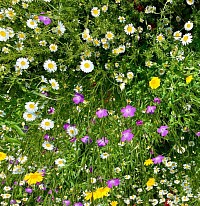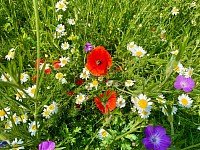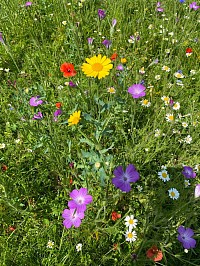Amazing things for you to do!
Create something blooming amazing today!
Below we’ll show you how to make wildflower seed paper, seed bombs or even a meadow with native species, which is a fantastic way to enhance local biodiversity, support pollinators, and enjoy beautiful blooms.
Remember to use wildflower seeds native to your region to support local ecosystems and biodiversity and always avoid chemicals.
Seed bombs and seed paper make great eco-friendly gifts for special occasions, weddings, or educational purposes.
Share your wildflower experiences and tips with our community, we’d love you to join our facebook group. Happy creating, everyone! 🌸🦋🌿
Wildflower Seed Paper
How to Make Wildflower Seed Paper
By creating seed paper you’ll contribute to the promotion of native wildflowers, enhance local habitats, and engage in a sustainable and creative activity that benefits the environment.
Materials Needed:
Wildflower seeds (native to your region)
Recycled paper (newspapers, printer paper, etc.)
Water
Blender or food processor
Mixing bowl
Strainer or sieve
Towels or sponges
Rolling pin or bottle
Baking sheet or mesh screen
Cookie cutters (optional, for shapes)
Natural dye (optional, for colour)
Steps for Seed Paper:
1. Shred the Paper: Tear the recycled paper into small pieces. Aim for about 1-2 cups of shredded paper.
2. Soak the Paper: Place the shredded paper in a bowl and cover it with warm water. Let it soak for at least 30 minutes to soften.
3. Blend the Paper Pulp: Transfer the soaked paper into a blender or food processor. Blend until you get a smooth, mushy pulp. You may need to add a bit more water to blend it effectively.
4. Strain the Pulp: Pour the paper pulp through a strainer or sieve to remove excess water. Press down gently to squeeze out as much water as possible, but keep the pulp moist.
5. Mix in Wildflower Seeds: Transfer the pulp into a mixing bowl. Add a small handful of wildflower seeds and mix well. Be gentle to avoid damaging the seeds.
6. Spread the Pulp: Lay a towel or sponge on a flat surface. Spread the seed-infused pulp evenly on the towel or sponge to form a thin, even layer.
7. Roll the Pulp: Place another towel or sponge on top of the pulp layer. Use a rolling pin or bottle to press down and squeeze out excess water. Ensure the pulp is flat and even.
8. Dry the Seed Paper: Carefully lift the top towel and transfer the pressed pulp onto a baking sheet or mesh screen. Let it air dry for 24-48 hours. You can place it in a warm, dry area or use a low-temperature oven to speed up drying.
9. Cut into Shapes: Once dry, you can cut the seed paper into shapes using scissors or cookie cutters. Shapes can be hearts, stars, or simply rectangles.
10. Store and Use: Store the seed paper in a cool, dry place. To use, plant the seed paper in soil, water it, and watch the wildflowers grow.
Create your own wildflower seed bombs
Creating your own seed bombs using wildflower seeds, recycled paper, and natural materials is a fun and eco-friendly way to promote native wildflower growth. Here’s a step-by-step guide:
Materials Needed:
Wildflower seeds (native to your region)
Recycled paper (newspapers, printer paper, etc.)
Water
Blender or food processor
Mixing bowl
Strainer or sieve
Tray or parchment paper
Natural dye (optional, for colour)
Steps for Seed Bombs:
Shred the Paper: Tear the recycled paper into small pieces. Aim for about 1-2 cups of shredded paper.
Soak the Paper: Place the shredded paper in a bowl and cover it with warm water. Let it soak for at least 30 minutes to soften.
Blend the Paper Pulp: Transfer the soaked paper into a blender or food processor. Blend until you get a smooth, mushy pulp. You may need to add a bit more water to blend it effectively.
Strain the Pulp: Pour the paper pulp through a strainer or sieve to remove excess water. Press down gently to squeeze out as much water as possible, but keep the pulp moist.
Mix in Wildflower Seeds: Transfer the pulp into a mixing bowl. Add a small handful of wildflower seeds and mix well. Ensure that the seeds are evenly distributed throughout the pulp.
Shape the Seed Bombs: Take small portions of the seed-infused pulp and roll them into balls, about the size of a marble. Alternatively, you can use moulds to create different shapes.
Dry the Seed Bombs: Place the shaped seed bombs on a tray lined with parchment paper. Let them air dry for 24-48 hours or until completely hard.
Store and Use: Store the dry seed bombs in a cool, dry place. When ready to use, throw or plant them in a desired location where they can grow.
Create a wildflower meadow
A wildflower meadow with native species is a delightful and sustainable addition to any garden. It enhances local biodiversity, supports wildlife, and creates a beautiful, ever-changing landscape. Whether you’re starting from scratch or adding to existing gardens, wildflowers will bring life and colour to your outdoor space. Enjoy the process of planting and watching your meadow grow into a vibrant haven for nature!
Benefits of a Wildflower Meadow:
Supports Wildlife: Provides habitat and food for pollinators, birds, and other wildlife.
Low Maintenance: Requires less maintenance than traditional lawns once established.
Biodiversity: Promotes plant diversity and resilience to pests and diseases.
Aesthetic Appeal: Offers a changing tapestry of colours and textures throughout the seasons.
Steps to Establish a Meadow:
Site Preparation: Choose a sunny spot and remove existing vegetation. If the soil is fertile, you may need to reduce nutrient levels by removing the top layer or introducing sand.
Sow Seeds: Mix wildflower seeds with dry sand for even distribution. Scatter the seeds over the prepared area and gently press them into the soil.
Watering: Water the area lightly and regularly until the seedlings are established. Avoid overwatering.
Maintenance: In the first year, mow the meadow a few times to control aggressive grasses and encourage wildflower growth. In subsequent years, mow once in late summer after most flowers have seeded
Wildflowers Native to the UK
Here’s a list of common wildflowers native to the UK that you could include in your meadow, along with some information about each one:
1. Cornflower (Centaurea cyanus). Bright blue flowers with a ruffled appearance. Bloom Time: June to August. Habitat: Prefers well-drained soils in full sun. Uses: Adds vibrant colour to meadows; attracts bees and butterflies.
2. Red Campion (Silene dioica). Pink to red flowers with deeply notched petals.Bloom Time: May to September.Habitat: Thrives in woodlands, hedgerows, and meadows.Uses: Provides nectar for moths and butterflies.
3. Common Poppy (Papaver rhoeas). Iconic red flowers with black centres. Bloom Time: June to August. Habitat: Prefers disturbed ground and full sun. Uses: Symbol of remembrance; attracts pollinators.
4. Oxeye Daisy (Leucanthemum vulgare). Large white daisy-like flowers with yellow centre's. Bloom Time: June to September. Habitat: Prefers grasslands and meadows. Uses: Attracts a variety of pollinators; commonly used in wildflower mixes.
5. Cowslip (Primula veris). Clusters of small yellow flowers on tall stems. Bloom Time: April to May. Habitat: Prefers grasslands and meadows. Uses: Provides nectar for bees and insects; adds early-season colour.
6. Meadow Buttercup (Ranunculus acris). Bright yellow, glossy flowers.Bloom Time: April to August.Habitat: Common in meadows and grassy areas. Uses: Attracts pollinators and provides a splash of color.
7. Field Scabious (Knautia arvensis). Pale lilac or blue flowers with a pincushion-like appearance. Bloom Time: July to September. Habitat: Prefers grasslands and meadows. Uses: Attracts bees, butterflies, and other pollinators.
8. Common Knapweed (Centaurea nigra). Thistle-like purple flowers. Bloom Time: June to September. Habitat: Found in meadows, pastures, and roadsides. Uses: Provides nectar for a variety of insects.
9. Bird’s-foot Trefoil (Lotus corniculatus). Bright yellow flowers sometimes tinged with red. Bloom Time: May to September. Habitat: Prefers dry, grassy areas.Uses: Host plant for butterflies; nitrogen fixer that enriches the soil.
10. Yellow Rattle (Rhinanthus minor). Yellow tubular flowers with a rattling seed pod. Bloom Time: May to September.Habitat: Prefers meadows and grasslands. Uses: Parasitic plant that helps control grasses, making space for other wildflowers.



